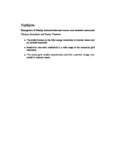Energetics of tidally induced internal waves over isolated seamount
| dc.contributor.author | Stashchuk, Nataliya | |
| dc.contributor.author | Vlasenko, Vasyl | |
| dc.date.accessioned | 2022-11-07T16:45:08Z | |
| dc.date.available | 2022-11-07T16:45:08Z | |
| dc.date.issued | 2022-09 | |
| dc.identifier.issn | 1878-433X | |
| dc.identifier.issn | 1878-433X | |
| dc.identifier.other | 103014 | |
| dc.identifier.uri | http://hdl.handle.net/10026.1/19918 | |
| dc.description.abstract |
Tidally generated internal waves over Rosemary Bank Seamount, North Atlantic, were investigated using the Massachusetts Institute of Technology general circulation model. The model results were validated against in-situ data collected during the 136th cruise of the RRS ‘James Cook’ in June 2016. The current study focuses on the sensitivity of the model output to the parameter settings. The estimates of the available potential energy integrated over the model domain were taken as a proxy for evaluating the sensitivity of the model results to the grid steps, horizontal and vertical viscosity, diffusivity, and mixing schemes. It was found that coarse grid models overestimate available potential energy converted to internal tides over seamounts. In fact, the energy conversion rate from barotropic to baroclinic tidal components is sensitive to the grid resolution. The reasons for this tendency are discussed in the paper. | |
| dc.format.extent | 103014-103014 | |
| dc.language | en | |
| dc.language.iso | en | |
| dc.publisher | Elsevier | |
| dc.subject | Internal tide | |
| dc.subject | Rosemary Bank Seamount | |
| dc.subject | Numerical modelling | |
| dc.title | Energetics of tidally induced internal waves over isolated seamount | |
| dc.type | journal-article | |
| dc.type | Journal Article | |
| plymouth.author-url | https://www.webofscience.com/api/gateway?GWVersion=2&SrcApp=PARTNER_APP&SrcAuth=LinksAMR&KeyUT=WOS:000841594100001&DestLinkType=FullRecord&DestApp=ALL_WOS&UsrCustomerID=11bb513d99f797142bcfeffcc58ea008 | |
| plymouth.volume | 114 | |
| plymouth.publication-status | Published | |
| plymouth.journal | Wave Motion | |
| dc.identifier.doi | 10.1016/j.wavemoti.2022.103014 | |
| plymouth.organisational-group | /Plymouth | |
| plymouth.organisational-group | /Plymouth/Faculty of Science and Engineering | |
| plymouth.organisational-group | /Plymouth/Faculty of Science and Engineering/School of Biological and Marine Sciences | |
| plymouth.organisational-group | /Plymouth/REF 2021 Researchers by UoA | |
| plymouth.organisational-group | /Plymouth/REF 2021 Researchers by UoA/UoA07 Earth Systems and Environmental Sciences | |
| plymouth.organisational-group | /Plymouth/Research Groups | |
| plymouth.organisational-group | /Plymouth/Research Groups/Marine Institute | |
| plymouth.organisational-group | /Plymouth/Users by role | |
| plymouth.organisational-group | /Plymouth/Users by role/Academics | |
| dcterms.dateAccepted | 2022-07-10 | |
| dc.rights.embargodate | 2023-8-9 | |
| dc.identifier.eissn | 1878-433X | |
| dc.rights.embargoperiod | Not known | |
| rioxxterms.versionofrecord | 10.1016/j.wavemoti.2022.103014 | |
| rioxxterms.licenseref.uri | http://www.rioxx.net/licenses/all-rights-reserved | |
| rioxxterms.type | Journal Article/Review | |
| plymouth.funder | Influence of population connectivity on depth-dependent diversity of deep-sea marine benthic biota::NERC |


